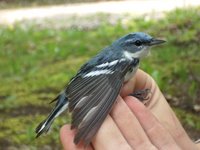The trouble with migration
 Seemingly the healthiest population in Ontario, Cerulean warblers at QUBS are a popular bunch. Dozens of birders can be found on any given weekend in spring descending on the mature, sugar maple forest in the Bonwill Tract. With their binoculars in tow, they flock from far and wide to catch a fleeting glimpse of sky-blue plumage high in the canopy.
Seemingly the healthiest population in Ontario, Cerulean warblers at QUBS are a popular bunch. Dozens of birders can be found on any given weekend in spring descending on the mature, sugar maple forest in the Bonwill Tract. With their binoculars in tow, they flock from far and wide to catch a fleeting glimpse of sky-blue plumage high in the canopy. Yet this population is in trouble, at least according to doctoral research conducted by Jason Jones at Queen's University.
Jason and his colleagues monitored the Cerulean warbler population at QUBS from 1995-2001. The canopy-dwelling birds were first lured into a mist-net and, while in the hand, they were given with a unique combination of coloured leg bands. The marked individuals were then visited on a regular basis to confirm their continued presence and to monitor their nesting activities, often in multiple years. Using those data, the researchers were able to generate population-level estimates for annual adult survival and fecundity. These basic demographic parameters, for an ecologist, serve as a pulse to monitor the health of a population. The diagnosis: not promising. The population is what is known as a “sink,” unable to compensate for annual mortality with local productivity alone. The QUBS population is not unique; Ceruleans have been declining in abundance throughout their range. The question is why.
Cerulean warblers are notorious for their dependence on contiguous tracts of mature deciduous forest for breeding. The habitat protected by QUBS meets such qualifications - so the question remains, why is this population apparently unable to sustain itself?
Possible answer: the non-breeding period. As migratory birds, Ceruleans are reliant on habitat in disparate geographic locations – on breeding areas, along migration routes, and on wintering areas. The trouble with migration is that habitat limitation in any one of those seasons can act as a population bottleneck. Over the past few decades, Ceruleans have faced a barrage of habitat destruction on their wintering grounds, an altitudinal zone in the Andes of South America that is ideal for coca production. Declines in Cerulean populations have, in part, been blamed on the loss of crucial over-wintering habitat. Direct evidence is lacking, however, because there is a dearth of information on this species in winter. Jason was able to get at this question indirectly using the breeding-season data from QUBS. He found that the vast majority of Ceruleans survive through the breeding season, but only half return to breed the following year. The non-breeding period, which includes both the migratory and over-wintering periods, must therefore be a major source of adult mortality.
That said, we cannot relinquish all responsibility to tropical nations. Low productivity during the breeding season at QUBS could also be blamed for the population's inability to sustain itself. Furthermore, recent surveys in forest patches surrounding the core QUBS habitat indicate that few are host to breeding pairs of Ceruleans. As our population grows and development continues, the importance of setting aside large tracts of contiguous forest (like QUBS) will become even more apparent. Birds and other forest-dwelling creatures will not be the sole beneficiaries. Where else would all those birders go in the crisp, clear mornings of spring?
Jones J, Barg JJ, Sillett TS, Veit ML, Robertson RJ (2004) Minimum estimates of survival and population growth for Cerulean warblers (Dendroica cerulea) breeding in Ontario, Canada. Auk 121: 15-22 [Full Text]

2 Comments:
I like birds. They make me happy. I like when they soar around the sky and make loops. I have never really seen a bird upclose. Some day I might try to catch a bird and tie a string to it. Maybe I could fly then.
fish biologists...
Post a Comment
<< Home